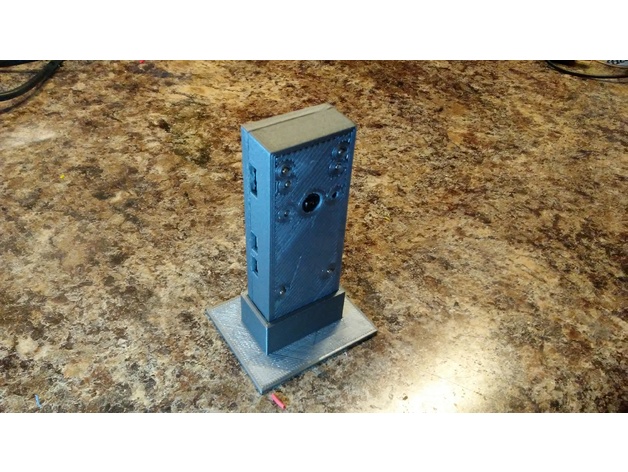
Raspberry Pi Zero W Case w/ Camera
thingiverse
This is a basic rectangular Pi Zero case with camera that I designed for remotely monitoring things around my house in Wi-Fi range. I'm using the Pi Zero W, which has Wi-Fi capabilities, and it's set up for headless (VNC) connection so it only needs a power supply to function. The RPi-Cam-Web-Interface makes it easy to monitor and control this unit from any device with a web browser. The case features a simple rectangular shape that allows it to rest on either its end or side, and it comes with a slide-on base for stability when standing the case on end. The HDMI, USB, and power connections are accessible, making it possible to connect it to a monitor and keyboard/mouse. There is enough space in the end of the case to weave the camera ribbon cable without kinking the ribbon. The Pi and camera are secured with M2 screws through printed standoffs, which eliminates the need for 2 mm diameter printed pins. The same M2 screws hold the case together. I used the Raspberry Pi Zero Version 1.3 Reference Model by Anathae as my design reference, published on June 6, 2016, and available here: http://www.thingiverse.com/thing:1612021 UPDATE 10/3/17: After printing another case, I made some improvements to the design. The files with "fixed" in their names are the improved versions. The tabs on the back of the case (PiZbottomFixed.stl) were pulled back a bit so that the case fits together without post-printing adjustment. The camera hole size was increased in the front of the case (PiZtopFixed.stl). Print Settings: Printer: MP3DP Rafts: No Supports: No Resolution: 0.2 mm Infill: 30% Notes: Printed in PLA Post-Printing: Assembly: You will need your Rpi Zero W with camera attached to the ribbon cable. Place the camera into the front case half and align the mounting holes over the four short standoffs. Attach the camera with short M2 screws. Place the Rpi zero over the camera on the long standoffs in the front case half. Let the camera ribbon fold in half without kinks. Fold the ribbon cable back and forth like a piece of ribbon candy in the bottom space in the front case half. It should weave back and forth a few times in the open space at the bottom of the case without kinks. Place the case back on and carefully close the case halves together. The ribbon should compress without kinking. Secure the entire assembly together with 4 M2 screws. The assembled case will slide into the base, which can be used with or without it. Assembly Tips: Test fit the case halves before inserting the camera or pi. Use a small file to clean up any artifacts so that the case halves fit together snugly but not too tight. Test fit the screw holes. You can use longer screws with nuts if needed. I drilled the holes in the case back so that the M2 screws slid in easily, and threaded the screws into the front case half standoffs. If you drill out the holes, do it from the outside of the case, not on the standoffs from the inside. The standoffs can snap off if there are any flaws in the bond between the layers. Drilling from the case outside reduces the likelihood of snapping off the standoff.
With this file you will be able to print Raspberry Pi Zero W Case w/ Camera with your 3D printer. Click on the button and save the file on your computer to work, edit or customize your design. You can also find more 3D designs for printers on Raspberry Pi Zero W Case w/ Camera.
